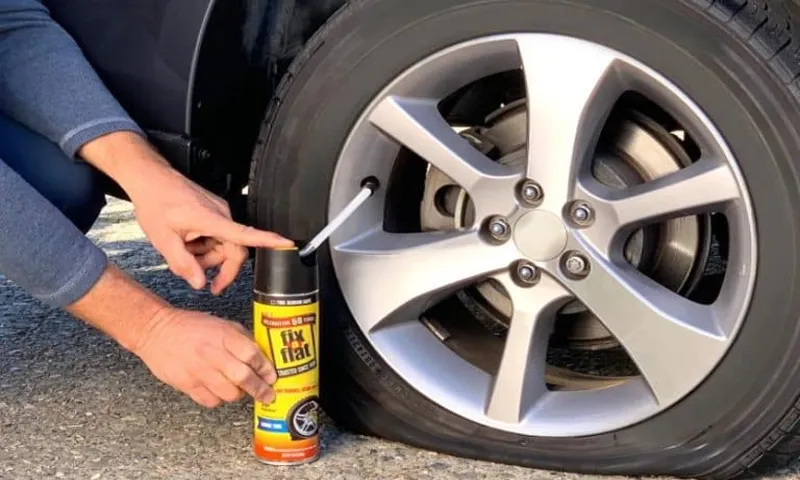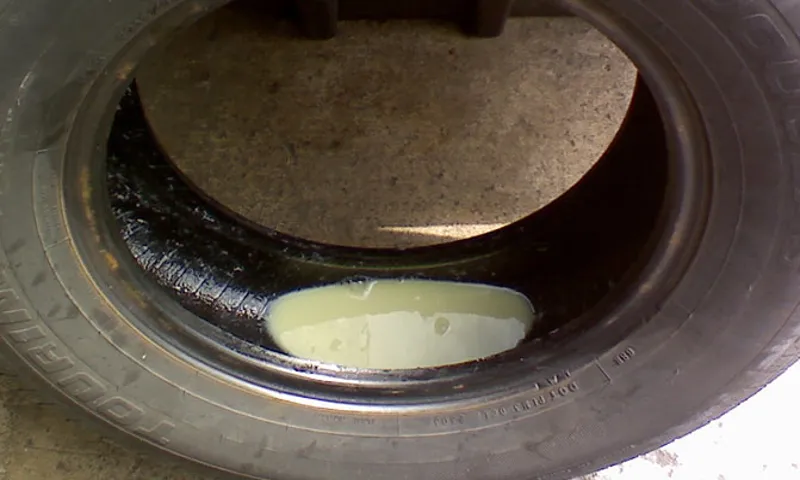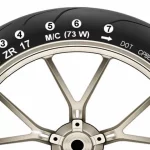When you get a flat tire, the last thing you want to do is spend hours waiting for a mechanic to show up. That’s where Fix-A-Flat comes in – the quick and easy tire repair solution that can get you back on the road in no time. But how long does Fix-A-Flat actually last in a tire? First, it’s important to understand what Fix-A-Flat is.
Essentially, it’s a foam-like substance that you can spray into your tire through the valve stem. As the foam spreads, it seals any leaks in the tire while also inflating it back to the proper level. Now, as for how long Fix-A-Flat will keep your tire functioning properly, the answer varies.
Some repairs can last for months, while others may only last for a few days. It depends on the severity and location of the leak, as well as how much pressure your tire is able to hold. It’s also worth noting that Fix-A-Flat is meant to be a temporary solution.
While it can fix your tire in a pinch, it’s not a substitute for getting a proper patch or replacement. If you use Fix-A-Flat, it’s important to get your tire checked out by a professional as soon as possible. In conclusion, Fix-A-Flat can be a lifesaver when you’re in a hurry and need to fix your flat tire quickly.
While it’s not a permanent solution, it can last for varying amounts of time depending on the circumstances. Just be sure to get your tire properly repaired as soon as possible to avoid any potential safety hazards.
Table of Contents
What is Fix-A-Flat?
Fix-A-Flat is a tire repair product that can be used in emergencies for quick and temporary solutions to a flat tire. Simply put, it inflates the tire and seals any leaks from within. However, it should be noted that Fix-A-Flat is not a long-term solution and should only be used as a temporary fix to get you home or to the nearest repair shop.
As for how long it lasts in a tire, it depends on various factors such as the severity of the puncture, the size of the tire, and driving conditions. Generally, it is recommended to have the tire repaired or replaced within 24-48 hours of using Fix-A-Flat as it can potentially cause damage to the tire if left in for too long. It’s always better to be safe than sorry when it comes to tire repair, and while Fix-A-Flat may seem like a quick and easy solution, it’s always best to have a professional assess and repair the tire properly.
Definition and Uses
Fix-A-Flat is a quick-fix solution in a can that is designed to inflate flat tires without needing to remove them from the vehicle. This product is made up of a mixture of compressed air and sealant that is injected through the tire valve to provide a temporary fix for punctures. Fix-A-Flat can be a lifesaver on the road when you’re stranded with a flat tire and don’t have the tools or knowledge to change it on your own.
It provides a convenient short-term solution that can get you to the nearest auto shop for a more permanent repair. However, it’s vital to remember that Fix-A-Flat is only meant to be used as a temporary fix until you can get your tire repaired or replaced properly. Overusing it can result in further damage to your tire and even compromise your vehicle’s safety.
Overall, Fix-A-Flat can be a helpful addition to your emergency car kit, but it’s essential to use it wisely.

How Does it Work?
Fix-A-Flat is a tire inflator that is used to fix flat tires. It is a quick and easy solution that can get you back on the road in no time. Fix-A-Flat works by injecting a sealant into the tire through the valve stem.
The sealant then coats the inside of the tire and seals any leaks that may have been causing the flat. It also pumps up the tire to the correct pressure so you can drive your car safely. Fix-A-Flat is a great option for emergency situations when you don’t have the time or ability to change a tire.
It is also convenient because it can be stored in your trunk and used at any time. However, it is important to note that Fix-A-Flat is not a permanent solution and should only be used as a temporary fix. It is recommended to have your tire professionally repaired or replaced as soon as possible.
How Long Does Fix-A-Flat Last?
If you’ve ever found yourself with a flat tire on the side of the road, you know how frustrating and time-consuming it can be to change it. That’s where Fix-A-Flat comes in. But how long does it actually last? The answer depends on a few factors, such as the severity of the leak, the size of the tire, and the driving conditions.
In general, Fix-A-Flat can provide a temporary fix for small to medium-sized punctures for several days or even up to a week. However, it’s important to remember that Fix-A-Flat is not a permanent solution and the tire will eventually need to be repaired or replaced. It’s also crucial to read the instructions carefully and use the product only in emergencies and as directed.
So, while Fix-A-Flat can be a helpful tool in a pinch, it’s best to get your tire fixed properly as soon as possible.
Factors That Affect Its Longevity
Fix-A-Flat is a popular tire sealant that can provide a temporary fix for punctured tires. However, the longevity of Fix-A-Flat depends on various factors. One important consideration is the size and location of the puncture.
If the puncture is too large or on the sidewall, Fix-A-Flat may not be effective. Another factor is the age of the product. Over time, the propellant in the canister can degrade and lose its effectiveness.
Additionally, climate and temperature can play a role in the longevity of Fix-A-Flat. Extreme temperatures, both hot and cold, can affect the sealant’s ability to adhere to the tire. It is important to note that Fix-A-Flat should only be used as a temporary fix and should not be relied upon as a permanent solution.
In summary, the lifespan of Fix-A-Flat varies depending on many factors, but it can provide a temporary fix for minor punctures in your tires.
Typical Lifespan of Fix-A-Flat
Fix-A-Flat is an incredibly useful product that can be a real lifesaver in a pinch. Whether you’ve got a slow leak or a completely flat tire, Fix-A-Flat can get you back on the road quickly and easily. But how long does Fix-A-Flat last once you use it? Well, the answer depends on the product you’ve used and the severity of the problem.
Most Fix-A-Flat products will provide a temporary fix that will last anywhere from a few days to a couple of weeks. However, it’s important to understand that Fix-A-Flat is not a permanent solution. If you’ve used Fix-A-Flat to seal a puncture, you’ll still need to take your tire to a professional and have it repaired or replaced as soon as possible.
Overall, while the lifespan of Fix-A-Flat may be temporary, it can certainly be a lifesaver when you’re in a pinch.
When to Replace the Tire or Repair the Puncture
Fix-A-Flat When it comes to tires, it’s important to know when to replace them versus when to repair a puncture. Generally speaking, if a tire has significant damage or wear and tear, it’s time to replace it. However, if the damage is minor, a repair may be enough to get you back on the road.
That’s where Fix-A-Flat comes in. This aerosol product can temporarily seal punctures and inflate the tire, providing a quick fix in an emergency situation. But how long does Fix-A-Flat actually last? While the answer can vary based on factors like the size of the tire and the severity of the puncture, in general, Fix-A-Flat is intended to be a temporary solution.
It’s designed to get you to the nearest tire repair shop or safely off the road, but it’s not a long-term fix. It’s important to get your tire repaired or replaced as soon as possible after using Fix-A-Flat. So, while Fix-A-Flat can be a useful tool in a pinch, it’s not something to rely on for an extended period of time.
Is Fix-A-Flat Reliable?
Are you wondering how long does Fix-A-Flat last in a tire? While using Fix-A-Flat can be a convenient quick fix for a flat tire, it’s not a long-term solution. The product is designed to temporarily seal punctures and inflate the tire so you can safely drive for a short distance. However, it’s important to note that Fix-A-Flat is not a permanent solution, and it’s recommended to get your tire properly repaired or replaced as soon as possible.
The lifespan of the product depends on various factors such as the size of the puncture, the tread depth of the tire, and driving conditions. It’s crucial to follow the product instructions carefully and avoid over-inflating the tire as it can lead to further damage. While it’s tempting to solely rely on Fix-A-Flat, it’s essential to consider it as a temporary solution and prioritize getting your tire fixed by a professional.
Pros and Cons
When it comes to fixing a flat tire, Fix-A-Flat is one product that comes to mind. It’s a quick and easy solution that could save you the hassle of changing your tire. However, as with any product, there are pros and cons to consider.
On the one hand, Fix-A-Flat is incredibly convenient, providing a temporary fix to get you back on the road quickly. It’s also affordable and easy to use, requiring no special tools or skills. On the other hand, the sealant can create balance issues, making it difficult to drive at high speeds.
Additionally, it’s important to note that Fix-A-Flat is not a permanent solution and that you will need to have your tire repaired or replaced as soon as possible. Overall, Fix-A-Flat is a reliable option in emergency situations, but it’s essential to understand the limitations and use it as a temporary fix only.
Safety Concerns and Precautions
When it comes to safety concerns and precautions, many car owners wonder if Fix-A-Flat is reliable. While the product can be a quick and easy solution for fixing a flat tire, it’s important to understand its limitations and potential risks. Fix-A-Flat can provide a temporary fix for small punctures, but it may not work for larger or more severe tire damage.
Additionally, using the product improperly or relying on it as a long-term solution can lead to further damage or accidents on the road. It’s important to follow the product’s instructions carefully and have a professional mechanic inspect and repair the tire as soon as possible. Overall, while Fix-A-Flat can be a useful tool in emergencies, it’s essential to prioritize proper tire maintenance and seek professional help when needed to ensure safe and reliable driving.
Conclusion
In repairing a flat tire, Fix-a-Flat may seem like a miracle worker, but alas, even a wizard’s spells have limitations. Despite its efficacy in getting you back on the road, Fix-a-Flat does not last indefinitely. The amount of time it can hold up really depends on the severity of the puncture, the brand and quality of the product used, and the conditions the tire has been exposed to.
So, while Fix-a-Flat might temporarily fix your flat tire, it’s always best to get a permanent repair as soon as possible. Because let’s face it, even the best witchcraft won’t keep your tire fully inflated forever.”
FAQs
What is Fix-a-Flat and how does it work?
Fix-a-Flat is a tire repair aerosol that sprays foam into the tire to seal punctures. The foam inflates the tire and allows the vehicle to be driven to a repair shop.
Can Fix-a-Flat be used on all types of tires?
Fix-a-Flat is suitable for use on tubeless tires only. It is not recommended for use on motorcycle or ATV tires.
How long does Fix-a-Flat last in a tire?
Fix-a-Flat is a temporary solution and should only be used to get the vehicle to a repair shop. It is not designed to be a permanent fix, and the tire should be repaired or replaced as soon as possible.
Is Fix-a-Flat safe to use on a flat tire?
Fix-a-Flat is safe to use on a flat tire, but only as a temporary solution. It is important to repair or replace the tire as soon as possible for long-term safety.
Can multiple cans of Fix-a-Flat be used on the same tire?
Using multiple cans of Fix-a-Flat on the same tire is not recommended as it can cause damage to the tire and/or rim. It is best to use only one can per tire.
Can Fix-a-Flat be used to repair sidewall punctures?
Fix-a-Flat is designed to repair punctures on the tread area of the tire only. It is not recommended for use on sidewall punctures.
How should Fix-a-Flat be stored?
Fix-a-Flat should be stored in a cool, dry place and away from direct sunlight. It should not be stored in a vehicle or exposed to high temperatures.



